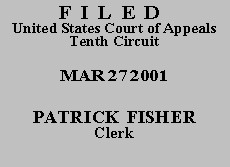

|
HAROLD DEAN COOKSEY, Petitioner-Appellant, v. GLYNN BOOHER, Respondent-Appellee. |
|
Before HENRY, BRISCOE, and
MURPHY, Circuit Judges.
Pro se petitioner, Harold Dean Cooksey, seeks a certificate of appealability ("COA") so he can appeal the district court's dismissal of his 28 U.S.C. § 2254 habeas petition. See 28 U.S.C. § 2253(c)(1)(A) (providing that no appeal may be taken from a final order disposing of a § 2254 petition unless the petitioner first obtains a COA). Cooksey also filed a motion seeking to proceed in forma pauperis on appeal; that motion is denied.
Cooksey filed his § 2254 petition with the United States District Court for the Western District of Oklahoma on September 11, 2000. In his petition, Cooksey raised only one issue: Cooksey claimed the sentence he received for a 1993 Oklahoma state conviction for bail forfeiture was improperly enhanced by a prior Texas conviction. The district court dismissed Cooksey's petition as untimely under the Antiterrorism and Effective Death Penalty Act ("AEDPA").
A review of the appellate record reveals that this is Cooksey's second petition for relief under 28 U.S.C. § 2254. On May 10, 1995, Cooksey filed a § 2254 habeas petition in the United States District Court for the Northern District of Texas. That petition was transferred to the United States District Court for the Northern District of Oklahoma where it was assigned Case No. 95-CV-1411-E. Cooksey filed an additional habeas petition with the United States District Court for the Northern District of Oklahoma in which he raised four additional issues. That petition was assigned Case No. 97-CIV-632-E. Although the respondent in that case argued that the petition filed in Case No. 97-CIV-632-E was a second or successive petition, the district court consolidated the two cases and analyzed all five issues raised in the two petitions. Similarly, all five issues were addressed by this court when it dismissed Cooksey's appeal. See Cooksey v. Champion, No. 99-5008, 1999 WL 363104 (10th Cir. June 7, 1999).
An applicant may not file a second or successive motion for relief pursuant to § 2254 in the district court until he "move[s] in the appropriate court of appeals for an order authorizing the district court to consider the application." 28 U.S.C. § 2244(b)(3)(A). Cooksey, however, filed the instant petition in the district court without first requesting permission from this court.(1) Consequently, the district court lacked jurisdiction over Cooksey's § 2254 petition and we, therefore, vacate its order dismissing the petition. Because we conclude that the instant § 2254 petition is successive, we construe Cooksey's application for a COA and appellate brief as a request for authorization to file a second or successive habeas petition. See Pease v. Klinger, 115 F.3d 763, 764 (10th Cir. 1997).
Pursuant to 28 U.S.C. § 2244(b)(1), "[a] claim presented in a second or successive habeas corpus application under section 2254 that was presented in a prior application shall be dismissed." It is clear that the only claim raised in this petition, i.e., that Cooksey's sentence was improperly enhanced by a prior Texas conviction, was raised in Cooksey's first § 2254 petition. See Cooksey, 1999 WL 363104, at *1. Accordingly, Cooksey is not entitled to file a second or successive § 2254 habeas petition for the purpose of relitigating this claim.(2) Cooksey's request for authorization to file a second or successive § 2254 petition is denied.
ENTERED FOR THE COURT
Michael R. Murphy
Circuit Judge
*. This order and judgment is not binding precedent, except under the doctrines of law of the case, res judicata and collateral estoppel. The court generally disfavors the citation of orders and judgments; nevertheless, an order
1.In the habeas petition Cooksey filed in the Western District of Oklahoma, he clearly indicated that he had filed a prior habeas petition. The Western District may have inadvertently failed to check this with the Northern District. To preserve scarce judicial resources, we encourage district courts to take particular care in determining their jurisdiction over a habeas petition before proceeding to the merits of the petition. When Cooksey's § 2254 petition was filed without the required appellate court authorization, the district court should have transferred it to this court. See Coleman v. United States, 106 F.3d 339, 341 (10th Cir. 1997) ("[W]hen a second or successive petition for habeas corpus relief under § 2254 . . . is filed in the district court without the required authorization by this court, the district court should transfer the petition or motion to this court in the interest of justice pursuant to [28 U.S.C.] § 1631").
2.The AEDPA applies because the instant petition was filed after the Act's April 24, 1996 effective date. See Hatch v. Oklahoma, 92 F.3d 1012, 1014 (10th Cir. 1996). Even if we were to apply pre-AEDPA standards, Cooksey's application to file a second or successive petition would be denied because his claim was rejected on the merits in his first petition and the "ends of justice" would not be served by a redetermination. Sanders v. United States, 373 U.S. 1, 15 (1963); Hawkins v. Evans, 64 F.3d 543, 547 (10th Cir. 1995) ("[A] federal court's rejection of a state habeas petitioner's constitutional claim on grounds of state procedural default is a determination on the merits for purposes of the Rule 9(b) successive petition doctrine.").